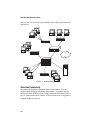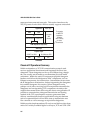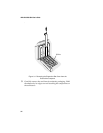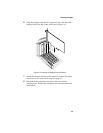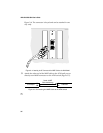
2-9
Introducing ATM Networking
LAN Emulation Configuration Server (LECS)
A LECS usually resides within an ATM switch. When queried by a
LEC over a Control Direct VCC, a LECS indicates what LAN(s) a LEC
can participate in based on input from a network administrator.
LECs use the LECS to obtain the network address of the LES. A
temporary VCC, that transports this information, is the Configuration
Direct VCC.
LAN Emulation Server (LES)
The LES maintains a table of all ATM nodes participating within a
LAN and can return appropriate values to querying nodes. The LES
usually resides within a node’s local switch and helps determine
node addresses.
To determine appropriate ATM addresses, a LEC maintains a table
of recently determined conversion values. When a value is not
within the table, a LEC contacts the LES using the LAN Emulation
Address Resolution Protocol (LEARP).
If a target node is an ATM end-station, the LES returns its address
and the process is complete. Otherwise the node is connected to a
legacy LAN which attaches to the ATM network using a transparent
bridge. If the LES does not have the appropriate MAC conversion
information to resolve addresses, the LES transmits associated
LEARP messages to the LES in any known transparent bridge using
Control Distribute VCCs. If a transparent bridge LEC recognizes the
specified MAC address, it provides the address to the original
requesting LEC and provides necessary message-passing facilities.
Broadcast and Unknown Server (BUS)
Occasionally, applications send LECs messages intended to be
broadcast to all LAN members. In this instance, the LEC passes the
message to the BUS using a multicast VCC. The BUS then transmits
the message to each participating LAN node using a multicast using
ATM multicast facilities. Receiving LECs filter these messages using
the node address and pass surviving messages to intended
recipients.
❒




